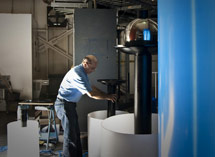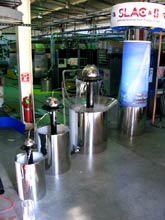
Handy Links
SLAC News Center
SLAC Today
- Subscribe
- Archives: Feb 2006-May 20, 2011
- Archives: May 23, 2011 and later
- Submit Feedback or Story Ideas
- About SLAC Today
SLAC News
Lab News
- Interactions
- Lightsources.org
- ILC NewsLine
- Int'l Science Grid This Week
- Fermilab Today
- Berkeley Lab News
- @brookhaven TODAY
- DOE Pulse
- CERN Courier
- DESY inForm
- US / LHC
SLAC Links
- Emergency
- Safety
- Policy Repository
- Site Entry Form

- Site Maps
- M & O Review
- Computing Status & Calendar
- SLAC Colloquium
- SLACspeak
- SLACspace
- SLAC Logo
- Café Menu
- Flea Market
- Web E-mail
- Marguerite Shuttle
- Discount Commuter Passes
-
Award Reporting Form
- SPIRES
- SciDoc
- Activity Groups
- Library
Stanford
Around the Bay
Fountain of Information
Water cascades over a reflective ball on the end of a six-foot tower, pooling in a basin before flowing down a thin ramp and into a smaller tank. As part of an enormous SLAC and Stanford display for the Super Computing 2009 Conference in Portland, Oregon, this outpouring represents the flow of data analyzed by tens of thousands of computers during a modern physics experiment.
"We wanted to make an analogy of data reduction with waterfalls," said coordinator Tofigh Azemoon, who last week finished constructing the giant exhibit at SLAC before shipping it to Oregon.
To achieve its data analogy, the exhibit features water rushing between ever-smaller fountains, representing the distillation of information through successive stages of analysis.
Modern-day physics experiments produce a flood of data—as many as 1000 terabytes per second—that require massive computation to filter relevant scientific information. The full flow of data from an experiment such as ATLAS, BaBar, the Linac Coherent Light Source or Large Synoptic Survey Telescope would quickly fill all storage space at SLAC, overwhelming researchers.
During analysis, meaningful measurements are separated from noise to produce a dataset that scientists can use to make discoveries. Azemoon explains that massive computing uses our present understanding of physics to home in on evidence used to generate new knowledge. His colleague Richard Mount, who helped devise the display, emphasizes that scientists have to use data that "tells an exciting story."
The completed exhibit will begin at an 11-foot poster display of one of the world's largest fountains, the Jet d'Eau in Geneva, Switzerland, which shoots 8,000 gallons of water per minute more than 450 feet into the air. This represents the deluge of data from a large physics experiment.
Then, a fountain that pumps 60 gallons per minute—a change of two orders of magnitude—corresponds to the data reduced at the first stage of data collection. Water representing data selected at each stage in the process pours down ramps between the successive fountains, which flow at ever-decreasing rates. The next one dribbles out a cupful per minute, then a half ounce, and finally, the "data" are condensed to single miniscule drop of water every two seconds.
Mount says the display is meant "to convey the enormity of decisions made in real time." The water's torrential, then tiny, flow will turn the imaginary ones and zeros of data analysis into something tangible.
The SC09 conference, which boasts more than 10,000 attendees, attracts many large vendors, including IBM, Microsoft and Intel, as well as major universities. SLAC's presence each year focuses on how computing contributes to science. In 2008, it exhibited a six-foot wall of 25 monitors that featured interactive animations and a 3-D projection system.
"We don't consider ourselves successful unless we can bring people in with something relevant to the science," says Mount. "And we always have to be pushing the envelope."
—Adam Mann
SLAC Today, November 12, 2009

